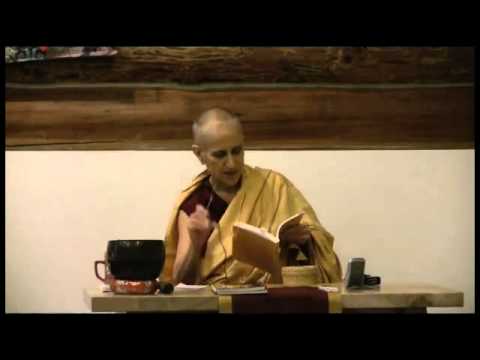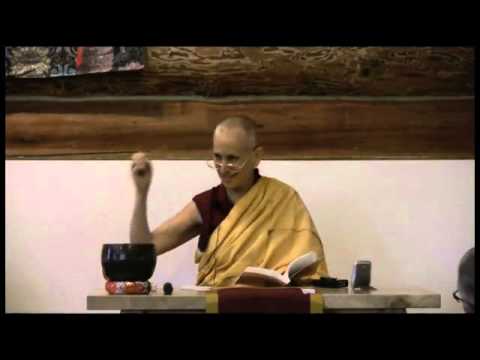Power of remedial action: Methods
Part of a series of teachings given at the Winter Retreat from December 2011 to March 2012 at Sravasti Abbey.
- The six types of remedial action according to the sutras
- Other actions that can serve as remedial action in the context of the four opponent powers
Vajrasattva 18: The power of remedial action, part 2 (download)
Six methods of applying remedial actions
We’ve been talking about the third of the four opponent powers, the power of remedial action. I’ll continue with that today. In the sutras and in Shantideva’s Compendium of Training they list six methods of applying remedial action to counteract our non-virtuous deeds. I’ll go over those. They’re kind of interesting actually.
First method: Relying on sutras
The first is relying on profound sutras. This antidote generally talks about relying on the sutra, like the Perfection of Wisdom sutras. By reading, memorizing, reciting, listening to teachings, or explaining them to others you can purify negative karma. The reason is because the main subject of the sutras is emptiness so reading these words of the Buddha then purifies the negativity. It also plants positive seeds into the mindstream.
Second method: Having an interest in emptiness
The second one is having an interest in emptiness. This means having confidence and conviction that emptiness of inherent existence is the ultimate mode of being of the self and of phenomena. Now, if we don’t understand emptiness—and I certainly don’t, I certainly haven’t realized any part of that yet—we can have confidence in the teachings. We can have confidence that we will be able to gain the realization of emptiness by studying, reading, listening to teachings, analyzing, and meditating. If we do that over and over again we will come to the full realization.
In The Steps on the Path to Enlightenment Geshe Sopa writes that:
The mere suspicion that ultimately things are empty of inherent existence has the power to shake the foundations of cyclic existence. It is the first glimpse of the truth and it opens the way to the direct realization of emptiness, which destroys the karmic seeds that cause our suffering.
Pretty important. Just thinking, “Maybe things aren’t as solid as they seem,” would be really helpful. That starts to put a crack in our cyclic existence.
As we’re reviewing our past negative actions it’s also really helpful to reflect on the causes and conditions that created them. So the circumstance, what our decision was, what we decided to do, all of that – if we start looking at all of that, that’s very helpful. We do that not so we can get either blaming or angry or depressed. We don’t do that for that reason. We do it because if we start looking at all the causes and conditions that brought the circumstance together, that starts helping us decrease this solid feeling we have that, “I’m separate,” and that “I’m unchanging, and I’m kind of solid.” It starts working with that a bit. If we start making things not so separate, not so solid, then we’re getting closer to what reality actually is. It’s very helpful to really reflect on all of the causes and conditions that created the circumstance that then resulted in the destructive action that we created.
Third method: Relying on recitation
The third method is relying on recitation. This is what we’re doing in this retreat, reciting the Vajrasattva mantra as we’re doing the visualization. Again, if we’re focused on how many recitations we can do in each session that does not bring about purification. Merely reciting mantras does not bring about the purification. We have to keep anchoring it in regret. Yangtse Rinpoche in Practicing the Path advises to:
Continue mantra recitation until you feel the signs of purification.
He talks about external and internal signs.
External signs are the dreams you have, that kind of thing. But he says the internal signs of purification are more important—and that is having fewer afflicted mind states arising. That’s having a strong sense of a new understanding. That’s having a powerful conviction in karmic cause and effect. It can be experiencing the arising of the pure mind of refuge. It can be having more faith in your spiritual teachers, and generally noticing that you’re having a deeper understanding of the teachings that you’re receiving, as well as the things that you’re studying or reading. So those are the internal signs.
Fourth method: Relying on images
The fourth method is relying on images. This is creating images of Buddha in the form of statues, thangkas, or tsa tsas. The most common method is to use a mold and make tsa tsas— small little images of Buddha figures.
Fifth method: Relying on reverence
The fifth one is relying on reverence. This includes honoring and demonstrating our respect for the Buddhas. The most common way to do that is by making offerings. It’s often done with making water bowl offerings—which is what we do on our altar every day. Again they stress that what we offer is not so important. We can use our imagination and create vast, beautiful offerings —turn the water into vast, beautiful offerings. What’s more important is the attitude that we have as we’re making the offerings. Again, if we’re doing this within the practice of the four opponent powers, we have to keep anchoring all of these actions within regret.
Sixth method: Relying on names
The sixth one is relying on names. This refers to reciting names of buddhas and great bodhisattvas. For example, reciting Shakyamuni Buddha’s mantra or His Holiness the Dalai Lama’s name mantra. Traditionally these practices are done in three-month retreat—this intense purification. When it’s done that way it really cuts through some of our obscurations. It really opens up our mind so that we can feel like we’re really progressing on the path. It’s a very powerful method.
Doing all of these different practices over years can prepare you, and prepare the mind, to do a longer retreat. That’s necessary. If we try to do a longer retreat with a lot of obscurations in our mind it wouldn’t work. It would be too hard.
Finally, although they talk about these six methods, they stress that any virtuous action that we do we can make it a remedial action. In this day and age we can think about any community service that we do. Volunteering in any programs to help people learn to read, to volunteer in homeless shelters, food banks—anything like that can then become a remedial action if we place it within the context of the four opponent powers.
Venerable Thubten Jigme
Venerable Jigme met Venerable Chodron in 1998 at Cloud Mountain Retreat Center. She took refuge in 1999 and attended Dharma Friendship Foundation in Seattle. She moved to the Abbey in 2008 and took sramanerika and sikasamana vows with Venerable Chodron as her preceptor in March 2009. She received bhikshuni ordination at Fo Guang Shan in Taiwan in 2011. Before moving to Sravasti Abbey, Venerable Jigme (then Dianne Pratt) worked as a Psychiatric Nurse Practitioner in private practice in Seattle. In her career as a nurse, she worked in hospitals, clinics and educational settings. At the Abbey, Ven. Jigme is the Guest Master, manages the prison outreach program and oversees the video program.


